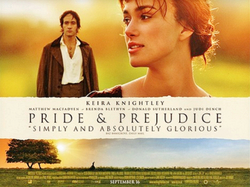If you’re interested in classic literature but aren’t sure where to start, here are four film adaptations to get you on the right track
By NATALIE SALTER — arts@theaggie.org
Reading classic literature is an undeniably enriching experience — however, the most famous of these novels can be daunting with their dense language and complex historical contexts. If this is a conflict preventing you from enjoying classic literature, a well-done cinematic adaptation of one of these books is a wonderful alternative to directly reading each one. Here are four of the best of these adaptations to add to your watchlist.
“Pride and Prejudice” (2005) dir. by Joe Wright
Jane Austen’s most famous novel has seen a number of adaptations and references throughout pop culture. While the best of these adaptations is hotly debated, the 2005 film starring Keira Knightley and Matthew Macfadyen has widely been hailed as one of the greatest. The story follows the stubborn and curious Elizabeth Bennet in her encounters with Mr. Darcy, a wealthy but unsociable man with whom she often quarrels. With an enchanting soundtrack, gorgeous cinematography, captivating performances and a truly memorable story at the heart of it all, “Pride and Prejudice” is more than just an adaptation — it is a love letter to Austen’s novel, understanding and reflecting on the characters with sincerity and palpable affection. Furthermore, the film is filled with heartwarmingly romantic scenes and iconic quotes that will live in your mind for weeks after watching.
“Emma” (2020) dir. by Autumn de Wilde
Another brilliant adaptation of one of Jane Austen’s bests is 2020’s “Emma,” starring Anya Taylor-Joy in the titular role of the affluent and confident Emma Woodhouse. Passionate about the art of matchmaking, Emma entangles herself in a web of flirtations, courtships and marriage proposals. Director Autumn De Wilde’s use of pleasant pastel colors throughout the film’s cinematography and set design creates a film that is as beautiful as it is entertaining. Likewise, “Emma” is backed by a brilliant cast that breathes life into the quirky and memorable characters and their various relationships. The film’s playful humor and intriguing twists follow the book incredibly accurately, and it captures the bright aura of Austen’s novel with ease.
“Jane Eyre” (2011) dir. by Cary Joji Fukunaga
Charlotte Brontë’s famous novel “Jane Eyre” is an icon of gothic literature that has experienced stunning longevity within academic circles. If the original novel is a bit too much of an undertaking for you, you’ll enjoy the 2011 film adaptation starring Mia Wasikowska as the protagonist Jane. She is swept off to become a governess under the purview of the mysterious Mr. Rochester, with whom she develops a complex relationship; however, she begins to discover that he conceals a troubling past. All of the gothic elements of the original novel are skillfully brought to life, creating a cinematic experience that is eerie and darkly atmospheric. “Jane Eyre” is subtle yet effective in its means of adapting the source material’s magnificent estates, shadowy forests and mysterious attics that harbor dangerous secrets. Furthermore, it brings the novel’s most memorable and impactful quotes to life with careful accuracy.
“Little Women” (2019) dir. by Greta Gerwig
While director Greta Gerwig shot to global fame for her work on 2023’s “Barbie,” her adaptation of Louisa May Alcott’s “Little Women” may be some of her best work. The film boasts a talented cast to play its four primary roles: the stubborn and playful writer Jo, played by Saoirse Ronan; thoughtful and romantic Meg, played by Emma Watson; strong-willed and artistic Amy, played by Florence Pugh; and the gentle and kind-hearted Beth, played by Eliza Scanlen. Gerwig’s adaptation strikes the core of the original novel’s themes of sisterhood and pursuing one’s dreams, bringing each sister’s story to life and giving viewers a deeper understanding of each of their hopes and aspirations. The film’s use of color grading, careful costuming choices and strategic shifts between past and present further enhance the original story. The result is an adaptation that does justice to its source material whilst also being deeply emotionally moving and cinematically beautiful.
Written by: Natalie Salter — arts@theaggie.org





